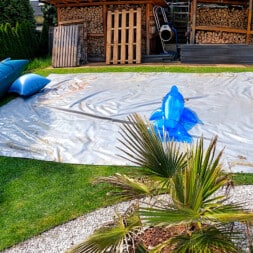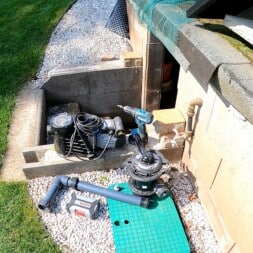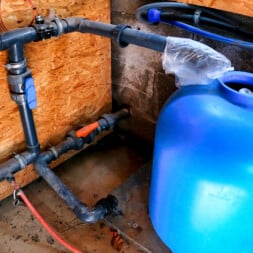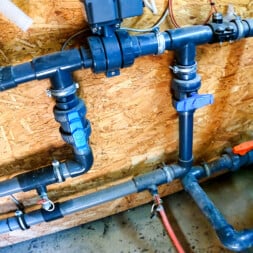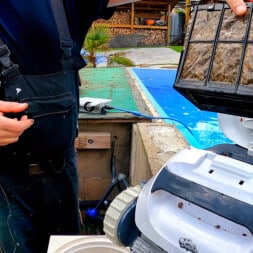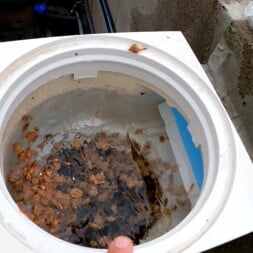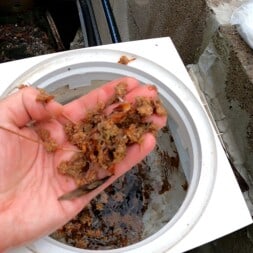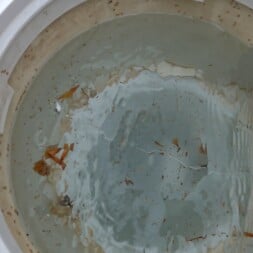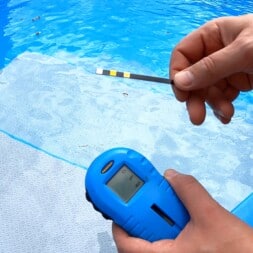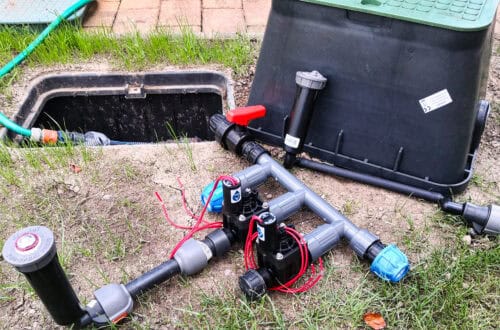
Winterizing the pool – putting pool technology into operation and adjusting water values
Winterizing the pool is at the top of my to-do list in spring.
The winter safety devices must be dismantled and the pool technology must be installed. The water values are checked and readjusted. The filter systems are also reactivated. So nothing stands in the way of a great swimming season.
In this article, you’ll find out which steps are important and how I prepared my pool optimally for sunny bathing days.
Winterizing the pool and bringing it out of hibernation
It’s mid-May, the birds are chirping and the sun is coming out more and more often – the perfect time to wake our beloved pool from hibernation. The pool season is due to start shortly.
One look at my pool, which has been resting under the protective winter tarpaulin, and it becomes clear: it’s time to bring the clear water, which has remained untouched for months, back to life.
The outdoor area around the pool needs attention, and even though the weather isn’t quite in summer mode yet, we’re not letting it stop us from taking the first steps towards winterizing the pool.
In this article, I’ll show you step by step how I bring my pool out of hibernation.
Removing the winter tarpaulin
The first stage of winterizing my pool begins with the winter cover, which protected the pool from snow and rain during the cold months.
First, I carefully remove the tensioning straps and hooks that held the winter tarpaulin securely on the pool. The 2 x 4 m XXXL pool cushion played a decisive role in this by keeping the winter cover constantly up so that snow and rain could run off to the side without any problems.
Although the cushion is large, it is not enough to lift the tarpaulin completely out of the pool. Water troughs have formed on the sides, which I regularly scooped out during the winter to prevent water from entering the pool.
The truck tarpaulin that covers my pool is sturdy and has stood the test of time. Only one eyelet on the south side was slightly torn by a tensioning strap, but this did not detract from the overall protection.
I had also weighted down the edges of the tarpaulin with heavy concrete blocks and filled 25 liter water canisters. This reliably prevented the wind from blowing under the cover and tearing it off. The stones and canisters are now safely stowed away again.
Once the tensioning straps and hooks have been removed, the next task is to skim off the accumulated water and remove the winter tarpaulin.
I’m curious to see what condition the water will be in after the winter, as I didn’t use any overwintering agents this year.
-
Price: € 145.22instead of: € 150.00
-
Price: € 23.40instead of: € 27.54
-
Price: € 4.99instead of: € 10.05
XXXL pool cushions and ice pressure pads
After removing the winter cover, I first took a look at the condition of the water in the pool. After six months of hibernation, the water looks surprisingly clear, even though some dirt has accumulated on the surface and the bottom of the pool.
After an initial test, I took the XXXL pool cushion out of the pool and cleaned it with water from the garden hose. Then I put it in the sun to dry.
To store the pool cushion safely and securely over the summer, I have to let the air out and pack it up properly. I put the pool cushion on the lawn and opened the valve, and the air escapes all by itself within an hour.
I only need a good 15 minutes to dismantle, clean and store the pool cushion.
The ice pressure pads are also dismantled and stored quickly. The black plastic bodies are stored in my garden shed over the summer.
I had placed the ice cushions diagonally in the pool. The robust yet flexible floats absorb the pressure of the ice layer when the water freezes. I use this method to safely protect my pool liner from the hard and sharp edges of the ice surface.
As soon as the water surface is now freely accessible, I can roughly clean the water with the landing net. In addition to a few leaves, I had an amazing number of earthworms in the pool water again this year.

- MATERIALSTÄRKE: Hochwertiges 0,44 mm starkes PVC, doppelvernäht – besonders widerstandsfähig gegen Chlor, UV-Strahlung & extreme Temperaturen bis -25°C.
- MAßE: 200 x 400 cm großes Luftkissen – Ideal für Winterabdeckung mit Plane.
- INKL. ZUBEHÖR: 4 Seile je 4 m zur Fixierung & 2 Reparaturaufkleber zur schnellen Schadensbehebung inklusive.
- EINFACHE ANWENDUNG: Sicherheitsventil für leichtes Aufpumpen – kompatibel mit elektrischen Pumpen, Hand- oder Fußpumpen.
- FÜLLHINWEIS: Empfohlene Befüllung zu 70–90 % für optimale Stabilität bei Temperaturschwankungen im Winter.
- WETTERSCHUTZ: Verhindert effektiv Wasseransammlungen, Pfützen & Frostschäden – ideal bei Schnee, Regen, Hagel oder längerer Abwesenheit.
- VIELSEITIG KOMBINIERBAR: Mit Ösen zur Verbindung mehrerer Kissen – ideal auch für größere Pools.
- LEICHTE REINIGUNG: Glatte Oberfläche für einfache Pflege – Schmutz, Laub und Wasser fließen leicht ab.
Fresh water for the pool in spring
The next crucial step is to fill the pool with fresh water.
In the fall, I drained the water to below the inlet nozzles to protect the water pipes and pool technology from frost damage. Of course, I now have to fill up the missing five cubic meters.
When I built the pool, I had already laid a supply line from the house connection to the pool house. I can now use a hose to connect the supply line directly to the pool’s pipe system.
So that the water can circulate in the pool and the connected pipe system, I must of course install the skimmer and remove the plugs from the inlet nozzles. The flexible pipe from the pump connection is reconnected to the drain of the skimmer using the screw connection.
The plugs on the inlet nozzles can be easily unscrewed. However, I only fit the directional spheres and the protective grids to the inlet nozzles at the end. This allows coarse dirt or even small animals to be flushed through the pipes into the pool.
However, the water is not let directly into the pool, but takes a detour via the solar heater.
To do this, I first channel the water through the inlet of my EPDM solar mats, which are positioned on the roofs of the wooden shelves. The water heated there then enters the pool through the two inlet nozzles.
In this way, I not only use the sun to heat water, but also check the functions of my solar heating at the same time. The entire pipe system is also flushed and vented at the same time.
As neither the pump nor the filter tank are connected at this time, the bypass to the solar system is shut off so that the water can only use the pipes of the heating system and the return to the water basin.
Zuletzt aktualisiert am 20. November 2025 um 20:29 . Ich weise darauf hin, dass sich hier angezeigte Preise inzwischen geändert haben können. Alle Angaben ohne Gewähr. (*) Bei den verwendeten Produktlinks handelt es sich um Affiliate Links. Ich bin nicht der Verkäufer des Produktes. Als Amazon-Partner verdiene ich an qualifizierten Verkäufen. Dein Preis ändert sich jedoch nicht.
Installing pool technology after the winter
Filling up will take about two to three hours, given the amount of water required and the capacity of my water connection. I will use this time to get the technology in the pool house working again.
I dismantled the pool pump and the reusable valve of the sand filter system (I have been using glass as a filter for many years) in the fall and stored them in the dry and warm cellar.
So now it’s time to take a look in the pool house, where a quick glance shows me that not much has happened during the winter. The filter tank, which I had already checked and rinsed out during winterizing, is clean and ready for use.
To prevent mice or other animals from getting into the open pipes, I had attached protective foil around the open pipe ends on the pump and multi-way valve. They will now be removed and stored for the next winter.
I remember an unpleasant experience when a mouse hid in the pipes when filling the pool. As I had already installed the protective grids on the inlet nozzles at the time, she was unable to escape any further and drowned miserably. I minimize such risks with the protective films.
I place the pump in the marked position and secure it with the two screws on the base plate. I can then connect the inlet from the skimmer to the pump inlet.
The riser pipe from the pump to the reusable valve is also reinstalled and securely screwed after I have screwed the valve firmly onto the filter bowl. Finally, the water pipes from the return and overflow are connected to the multi-port valve.
Now I check the motor of the bypass valve and the other shut-off valves to make sure they are working properly. Over the long winter it can happen that the stopcocks stick.
The system is now tight again and basically functional. If the water level in the pool continues to rise, the water can flow into the filter tank via the skimmer and the pump.
As soon as the skimmer is already a few centimeters in the water, I can activate the filter system. The pump then draws in the water from the skimmer and pushes it through the filter system.
If the water level is too low, the skimmer empties and the pump draws air. In this case, I have to wait until there is enough water in the pool.

- NACHHALTIG - Filterglas ist eine umweltschonende Alternative zum Filtersand, Quarzsand oder Filterbällen. Das nachhaltige Glasgranulat nutzt sich durch die Reibung im Filterkessel der Sandfilterpumpe nicht ab, das Material kann sich nicht verdichten und der optimale Wasserdurchfluss in Ihrem Poolfilter bleibt stets gewährleistet. Das Filterglas lässt sich dadurch bis zu 10 Jahre wiederverwenden mit 20 % weniger Materialverbrauch: 25 kg Filtersand entsprechen 20 kg Filterglas.
- AUSGEZEICHNETE WASSERQUALITÄT - Das für Poolfilteranlagen genutzte Filterglas ist zu 100 % frei von Verunreinigungen, verhindert die Bildung von Keimen sowie Biofilm und filtert selbst kleinste Partikel aus dem Schwimmbecken. Das Filterglas reduziert den Wasser-, Chemie- & Energieverbrauch. Dank der MC2 Anti-Verdichtungs-Technologie entstehen keine Verklumpungen oder organische Ablagerungen.
- HERKUNFT & ANWENDUNG - Das Filterglas wird ausschließlich aus naturreinem, weißem Glas (kein Altglas!) aus Produktionsüberhängen der Glasindustrie hergestellt. Es ist einsetzbar für alle gängigen Sandfilteranlagen mit feiner (0,4 - 0,8 mm) und grober Körnung (0,7 -1,2 mm).
- QUALITÄT AUS EUROPA - Das kristallklare weiße Hi-Tech Filterglas wird ausschließlich in Europa hergestellt. Es erfüllt alle erforderlichen Anforderungen für die Wasseraufbereitung und gewährleistet eine optimale Poolreinigung bei extrem verkürzter Rückspülzeit & geringstem Wasserverbrauch.
- LIEFERUMFANG - 1x 20 kg Filterglas als umweltschonende Alternative zum Filtersand – in bester Qualität von Poolomio – bis zu 10 Jahre verwendbar.
Video: Winterizing the pool properly
I have documented the winterizing of my pool in a video. In the movie I show all the steps individually and give additional hints and tips.
You can also find the video and many more in my playlist: Project Pool
If you want to see more of me and my projects, have a look at my YouTube channel.
Winterizing the pool – Pool robot works overtime
I have been using a pool robot to clean the pool for many years. I have described my experiences with the robot so far in this article: Is a pool robot worth it?
As I have already removed the coarse dirt from the water with the landing net, the pool robot is left with the somewhat smaller dirt particles. It also polishes the pool liner with its roller and thus reliably cleans it of algae and other deposits.
After the coarsest dirt has been removed, I use the pool robot. In the first cleaning round, the robot collects an impressive amount of dirt, including woodlice, earthworms and millipedes, in the filter basket.
In some years I had to interrupt the first cleaning cycle after a while to empty the filter basket. The water quality was better this year. Intermediate emptying of the filter basket was therefore not necessary.
Once the first round of cleaning is complete, I remove the filter basket and clean it thoroughly under running water. To my astonishment, a relatively large proportion of the worms in the basket were still alive. I have no idea how long an earthworm can survive under water.
As soon as the basket is clean and ready for use again, the second round can begin. As the pool robot needs around 90 minutes for one cleaning cycle, I plan at least three hours for my two cleanings.
But when I look at the pool and the water in the warm spring sunshine, I also appreciate this effort. Everything is now spotlessly clean.
To keep it that way, I now have to take care of my filter systems and make sure the water values are set correctly.
Zuletzt aktualisiert am 21. November 2025 um 20:35 . Ich weise darauf hin, dass sich hier angezeigte Preise inzwischen geändert haben können. Alle Angaben ohne Gewähr. (*) Bei den verwendeten Produktlinks handelt es sich um Affiliate Links. Ich bin nicht der Verkäufer des Produktes. Als Amazon-Partner verdiene ich an qualifizierten Verkäufen. Dein Preis ändert sich jedoch nicht.
New skimmer net and fresh flock cartridges
Now that the pool is filled with water, I turn my attention to further cleaning and maintenance. The water quality appears to be surprisingly good after six months of hibernation, despite the lack of overwintering agents.
There is a lot of dirt floating on the surface, but the water itself looks clear. And while the robot is busy cleaning the bottom of the pool, I can take care of the filter in the skimmer.
Due to the current of the water circulation and the additional turbulence caused by the robot, a lot of dirt is already being carried to the water surface and thus into the skimmer.
In addition to a few insects and pine needles, a surprising number of beech blossoms have collected in the skimmer basket this year.
Insects, pine needles and flowers are reliably retained by the filter basket in the skimmer. As soon as the basic cleaning is complete, the filter function is further optimized. In addition to a flocculant, I also use special filter socks or filter nets.
The filter nets consist of a fine fiber structure that is reminiscent of nylon tights. With their size and shape, they fit exactly over the opening of my filter basket in the skimmer.
Thanks to the very good filter effect of these filter socks, not only coarse dirt is now reliably filtered but also significantly smaller particles. Dust, pollen and small suspended particles collect on the fine structure and thus protect the downstream filter systems.
For cleaning, the filter net can simply be rinsed out under clear water. Reuse means it needs to be replaced less frequently. I get by with two or three of these filter socks during the season.
The cartridge with the flocculant, which I place under the filter net in the skimmer basket, gradually dissolves in the water. It binds the finest suspended particles in the water into a larger structure and thus optimizes the filter effect.
The cartridges I use last about three weeks before I have to put a new cartridge in the basket. So I get by with one pack per season.
Based on my very good experience with the additional filter nets and the flocculant in the skimmer basket, I can only recommend this procedure.

- VERMEIDEN SIE TEURE REPARATUREN: Pool-Skimmer-Socken schützen das Pumpenlaufrad und die Wellendichtung vor Beschädigungen oder Verstopfungen und verlängern so die Lebensdauer Ihres Pool-Filtersystems.
- NETZFILTERSOCKEN: Diese Filtersocken aus Nylon sind einfach zu installieren, Sie können sie problemlos am Korb anbringen und wieder abnehmen und sie helfen dabei, Hundehaare, Staub, Öl, Blätter, Kiefernnadeln, kleine Käfer und anderen Schmutz aufzufangen.
- ULTRA-LANGLEBIGE NETZ-SOCKEN FÜR POOL-SKIMMER: Diese hochwertigen Nylon-Filtersocken für Poolkörbe bestehen aus ultrafeinem Netz und strapazierfähigem Gummiband und können viele Male wiederverwendet werden.
- EINFACHE INSTALLATION – Der einfach zu dehnende Stoff passt perfekt über Ihren Pool-Skimmerkorb. Der Korbgriff lässt sich für eine noch einfachere Handhabung einfach wieder anbringen. Ersetzen Sie den Skimmerkorb alle 2–8 Wochen durch einen neuen.
- UNIVERSAL EINSETZBAR: Diese Pool Skimmerkorb Socken passen auf Skimmerkörbe jeder Größe und Form. Hinweis: Der Skimmerkorb ist nicht im Produktpaket enthalten.
Measure and check water values in the pool
In addition to the filters, the pH value and the chlorine value of the water are very important for unadulterated bathing fun. Although there are also pools that are disinfected and cleaned with salt water or active oxygen, I still use chlorine to ensure the water quality.
Chlorine, in the form of chlorine compounds such as sodium hypochlorite, is added to ensure effective disinfection. This chemical reaction causes chlorine to be released, which then kills bacteria, algae and other microorganisms in the water.
The oxidizing effect of chlorine plays a key role in removing organic impurities such as sweat and skin cells from the pool.
The correct dosage is crucial to ensure sufficient disinfection without endangering the health of swimmers.
The recommended chlorine levels for pool water are generally between 1.0 and 3.0 ppm (parts per million), although regular measurement and adjustment is necessary to maintain these levels.
It is important to distinguish between free chlorine and combined chlorine. Free chlorine is the effective, disinfecting chlorine in the water, while combined chlorine has formed compounds with organic substances and therefore no longer has a disinfecting effect.
The correct ratio between free and combined chlorine is therefore crucial for the effectiveness of disinfection in the pool.
There are many different methods for determining the correct chlorine content in pool water. In addition to the test strips, where you have to read the values using a color scale, there are also technical solutions such as the Aqua Chek I use.
The Aqua Chek allows pool owners to monitor water chemistry with ease, without the need for expensive laboratory equipment.
It is very easy to use – after immersing the test strip in the pool water, it is inserted into the notch with the Aqua Chek sensors and the start button on the device is pressed.
The device automatically determines the exact measured values for important parameters such as the pH value, chlorine content and alkalinity from the values on the test strip.
A video with detailed instructions on how to use the water tester correctly can be found further down in this article.
Video: Correctly determine the pH value and chlorine concentration in pool water
With this digital water tester, the values for chlorine, pH value and alkalinity can be read out quickly and easily. In the video I show how to use the device and give additional tips and advice.
You can also find the video and many more in my playlist: Project Pool
If you want to see more of me and my projects, have a look at my YouTube channel.
Chlorine content – pH value – Alkalinity
I am lucky that my water values are usually already very good. However, even I can’t avoid readjusting the water values in spring. My main focus is on adjusting the pH value and the chlorine content.
The correct chlorine value in the pool water
As described above, the ideal chlorine value is between 1.0 and 3.0 ppm (parts per million). As the chlorine in the water is continuously breaking down, the actual value in spring is usually lower.
Increasing the chlorine value is relatively simple.
In addition to chlorine tablets or tabs, which release the chlorine gradually, there are also concentrates for a quick and immediate increase in the chlorine content in the water.
In my experience, however, it is not so easy to lower the chlorine level as there is no chlorine reducer. If the value is too high, it only helps to change the water until the values are right again.
The correct pH value in pool water
The pH value in the pool water also plays a decisive role in the water quality and the well-being of swimmers. A balanced pH value is essential to protect the skin and eyes and to ensure the effectiveness of disinfectants.
A pH value between 7.2 and 7.6 is optimal, as it keeps the water slightly alkaline. This not only prevents irritation, but also promotes the effectiveness of disinfectants such as chlorine.
Various factors influence the pH value, including sweat, sunscreen and organic impurities.
To regulate the pH value, pH reducers or pH raisers can be used.
The right alkalinity in pool water
The importance of alkalinity in pool water lies not only in its role as a pH buffer, but also in its fundamental function for water chemistry. The alkalinity serves as a buffer solution that minimizes pH fluctuations and thus stabilizes the pool water.
This buffer mechanism prevents extreme fluctuations in pH value, which would be problematic both for the swimmers’ skin and for the effectiveness of disinfectants.
Alkalinity also influences the ability of water to absorb acids, which has a direct effect on the pH value. A balanced alkalinity value facilitates pH regulation and helps to ensure that the pool water remains clear and pleasant.
The optimum alkalinity value should be between 80 and 160 mg per liter.
There are also lifting and lowering water additives for adjusting the alkalinity.
Set the water values in the pool correctly
Now that I have described the ideal values for chlorine content, pH value and alkalinity, the exciting question is: How exactly do I adjust my actual values to the target values?
I would now like to describe this using my pH value as an example:
The measurement with my Aqua Chek showed a pH value of 6.5. The recommended 7.2 to 7.6 is therefore still 0.7 to 1.1 short.
The following calculation is based on an increase of 0.7 and a water volume of 24m³ in my pool. In addition to these two values, I also need to know the effectiveness of my pH-Plus water additive. This information can be found on the packaging and is usually given in grams per m³.
The agent I use can raise the pH value by 0.1 with 100g pH-Plus per 10m³.
Since I have to increase the value by 0.7 for 24m³, I calculate the required quantity as follows:
((0.7 x 100g) / 10m³) x 24m³ = 1,680g
So I need 1,680g of my pH+ agent to raise the entire water in my pool from 6.5 to the desired 7.2.
I can now measure the required amount with a measuring cup and mix it in a bucket with some pool water.
Gloves should be worn when doing this. The mixture is highly alkaline. In addition to a strong heating which can lead to burns, it attacks the skin in this concentration and can lead to damage.
I would not recommend adding it directly to the pool water as the granules do not dissolve quickly enough and can therefore cause stains on the pool liner.
In my opinion, it makes more sense to pour the pH+ concentrate slowly into the water flow of the inlet nozzles. This ensures that the product is optimally distributed in the pool.
The chlorine and alkalinity of the water can now be adjusted in the same way.
As the measures mentioned above are quite complex and are primarily necessary for the start of the season, a method is needed to continuously add the necessary additives to the pool water.
I use a dosing station for 200g Multitabs for this. The tablets contain all the necessary substances. The dosing station ensures that the tablet dissolves at the right speed and releases the substances into the water.



Solar tarpaulin for the summer
At this point, the pool has already been fully awakened from hibernation. I also fitted the protective grilles and the small balls for guiding the water direction in the inlet nozzles.
All the preparations are complete and I can start preparing the pool terrace for the coming swimming season.
However, the bathing fun would be somewhat spoiled if I didn’t ensure that the quality of the water and the temperature were kept at my desired level during the season.
While I am always dependent on the weather for the water temperature of the pool, despite automatic solar heating, I have a lot of control over the quality of the water.
In addition to regular cleaning of the filters, it is extremely helpful to significantly reduce the amount of dirt entering the bath water in advance.
My solar tarpaulin offers a great opportunity to combine the two factors in a sensible way. The solar cover uses the natural energy of the sun to heat the pool water, which not only contributes to a pleasant temperature, but also reduces operating costs in the long term.
The solar tarpaulin I use has a film thickness of 500mµ. The many “Geo Bubbles” not only provide the necessary buoyancy when the tarpaulin is on the water, but also form a super insulating layer. The heat in the water is retained even at cooler outside temperatures.
As the sun heats up the pool liner, it acts as a heater during the day. But I couldn’t heat my 24m³ of pool water with the solar cover alone.
The colour scheme – blue at the top, black at the bottom – also minimizes the amount of light entering the pool. Algae and other organisms therefore have an even harder time developing in my pool. This can be seen positively in the filter systems.
A final and, for me, crucial point is of course protection against dirt entering the water. The solar tarpaulin fits perfectly in the pool. Flowers, pollen, bird droppings and insects have no access to the water.
The solar tarpaulin is then simply rolled up before bathing and nothing stands in the way of a dip in the refreshing water.

- Maximale Algenhemmung
- Gute Erwärmung
- GeoBubble New
- 500 µm Materialstärke
- Verhindert Verdunstung

- Leistungsstarke Wandreinigung: Hervorragende Kletterfähigkeiten ermöglichen eine effiziente Reinigung des Bodens und der Wände, unabhängig von Poolform und Oberflächenbeschaffenheit.
- Kraftvolle Reinigung: Dieser Poolreinigungsroboter ist mit einer aktiven Bürste ausgestattet, die Schlamm, Schmutz, Algen, kleine Blätter, Ungeziefer und andere Verunreinigungen fachmännisch entfernt und eine gründliche Tiefenreinigung gewährleistet.
- Einschichtige Filtrierung: Eine fortschrittliche Filtrationstechnologie, die Blätter und andere größere Verschmutzungen auffängt.
- Schnelle Wasserablass: Schneller Wasserablass für einfaches Herausheben aus dem Becken, ergänzt durch ein ergonomisches Design für mühelose Handhabung.
- Entwickelt von Maytronics, dem weltweit führenden Unternehmen für Poolreinigungssysteme. Umfassend getestet und zuverlässig, einschließlich einer 2-Jahres-Garantie.
Summary and conclusion
Winterizing my pool in spring involved several important steps in order to be optimally prepared for the upcoming swimming season.
First I removed the winter cover and checked the condition of the water, which was pleasingly clear, even though I had not used any overwintering agents.
I then filled the pool with fresh water after reducing the water depth in the fall to avoid frost damage.
The pool technology, including the pump and filter system, was reinstalled and made functional again.
I paid particular attention to the water values, which I carefully measured and adjusted accordingly to ensure ideal water quality. The pH value, chlorine content and alkalinity were of particular importance here.
I used my tried-and-tested pool robot as an effective cleaning tool to remove dirt from the pool floor.
To keep the pool clean during the season and maintain the water quality, I used a dosing station for Multitabs, which ensured a continuous supply of the necessary chemicals.
Finally, I installed a solar tarpaulin, which not only helped to heat the water, but also served as protection against dirt ingress and minimized the formation of algae.
Thanks to this thorough preparation, my pool was optimally equipped for the sunny days and ready for an untroubled swimming season.
What do you think of my approach? What tips do you have for me? What can you recommend? I’m already looking forward to your comments.

- ✅Erleben Sie die mühelose Rundum-Lösung: Geben Sie einfach eine Multifunktionstablette in den Skimmer und lassen Sie sich vom 5-in-1-Effekt verzaubern. Mit nur einer Tablette erhalten Sie alle wesentlichen Vorteile, ohne umständliches Abmessen und Herumhantieren.
- ✅Genießen Sie die umfassende Pflegewirkung in fünf Phasen: Die spezielle chemische Zusammensetzung der 200g-Tabletten mit 5-in-1-Wirkung löst sich langsam auf und startet sofort mit der Phasenwirkung zur kontinuierlichen Desinfektion.
- ✅Die Formel von Meinpool24.de ist das Ergebnis umfangreicher Erfahrung aus dem Forschungs- und Entwicklungslabor. Unsere Produkte durchlaufen fortlaufende und strenge Qualitätsprüfungen, um höchste Standards sicherzustellen.
- ✅Bitte bachten Sie: es handelt sich um ein Produkt, welche 5 verschiedene Wirkweisen enthält - es sind keine 5 Produkte ✅ ideal für Pools ab 25m³ -> für kleinere Pools haben wir Minitabs im Sortiment
- BAuA Reg.-Nr.: N-111918 Biozidprodukt. Vorsichtig verwenden. Vor Gebrauch stets Etikett- und Produktinformationen lesen
FAQ on winterizing the pool
1. why is it necessary to winterize the pool?
Winterizing is important to prepare the pool for the summer after the cold season. The winter safety devices are removed, the pool technology is installed and the water values are adjusted. This ensures that the pool water is clean and safe for the swimming season.
2 When is the best time to winterize the pool?
Winterizing should take place in spring when the outside temperatures are permanently above 15 °C. Starting too early can cause damage to the pool technology due to late frosts.
3. what steps are necessary when winterizing the pool?
- Removing the winter cover and checking the water condition
- Cleaning the pool water and pool liner
- Filling the pool to the required water depth
- Installation of pool technology such as pump, filter and skimmer
- Checking and adjusting the water values (pH value, chlorine, alkalinity)
- Activation of the filter system and possible initial cleaning with a pool robot
4. how should the winter cover be removed?
First, all fastenings such as tension belts or weights must be removed. The water that has collected on the tarpaulin is then skimmed off. The cover should be carefully removed and thoroughly cleaned before it is stored.
5. how much water should be added after the winter?
The amount depends on how much water was drained in the fall. As a rule, the water level should be raised to a height just above the center of the skimmer in order to operate the pool technology properly.
6 When should the pool technology be reinstalled?
The pool technology is installed as soon as the water level is high enough for the pump to draw in water. The filter tank, the pump and all pipes must be checked for leaks.
7. how often should the water values be checked?
The water values should be checked before the first bath and adjusted if necessary. Regular weekly checks are advisable during the season to ensure stable water quality.
8. which water values are particularly important?
- pH value: Should be between 7.2 and 7.6 to ensure the effectiveness of disinfectants and the comfort of the swimmers.
- Chlorine value: Should be between 1.0 and 3.0 ppm to ensure sufficient disinfection.
- Alkalinity: Should be between 80 and 160 mg/l to stabilize the pH value.
9 Why is a solar tarpaulin useful?
The solar tarpaulin heats the water using solar energy and reduces heat loss at the same time. It also protects the pool water from dirt ingress and minimizes algae formation as it limits the amount of light entering the pool.
10. how does a pool robot help with winterizing?
A pool robot cleans the pool floor and walls of dirt, algae and deposits that have accumulated over the winter. It can help to get the pool ready for use more quickly after the winter break.

- ✅Erleben Sie die mühelose Rundum-Lösung: Geben Sie einfach eine Multifunktionstablette in den Skimmer und lassen Sie sich vom 5-in-1-Effekt verzaubern. Mit nur einer Tablette erhalten Sie alle wesentlichen Vorteile, ohne umständliches Abmessen und Herumhantieren.
- ✅Genießen Sie die umfassende Pflegewirkung in fünf Phasen: Die spezielle chemische Zusammensetzung der 200g-Tabletten mit 5-in-1-Wirkung löst sich langsam auf und startet sofort mit der Phasenwirkung zur kontinuierlichen Desinfektion.
- ✅Die Formel von Meinpool24.de ist das Ergebnis umfangreicher Erfahrung aus dem Forschungs- und Entwicklungslabor. Unsere Produkte durchlaufen fortlaufende und strenge Qualitätsprüfungen, um höchste Standards sicherzustellen.
- ✅Bitte bachten Sie: es handelt sich um ein Produkt, welche 5 verschiedene Wirkweisen enthält - es sind keine 5 Produkte ✅ ideal für Pools ab 25m³ -> für kleinere Pools haben wir Minitabs im Sortiment
- BAuA Reg.-Nr.: N-111918 Biozidprodukt. Vorsichtig verwenden. Vor Gebrauch stets Etikett- und Produktinformationen lesen
Dieser Beitrag ist auch verfügbar auf:
English
Deutsch





















